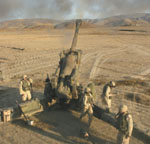Semantic Web Ready for Prime Time
 |
 |
 |
| To fully realize its goals for a network-centric force, the U.S. Defense Department is examining the use of semantic web technology, which permits information to be shared, stored and reused across application, enterprise and community boundaries. Highly scalable, it also allows legacy software tools to interoperate, enhancing joint and coalition operations. |
A World Wide Web-enabled technology is on the verge of dramatically changing the way people and computers interact and share information. It provides a common architecture that permits data to be communicated and reused across application, enterprise and community boundaries. This automated context mapping capability will allow complex network-centric systems to reach their full potential and to scale beyond present systems.
Current computer networks are reaching the limits of their ability to process information efficiently. This is not an issue of microchip speeds but of programming frameworks. Web searches that bring back thousands of topics are of little use if the data has no context. By creating a methodology to tag and arrange information, researchers are developing an automated system that allows data to be retrieved, cataloged and shared to meet an individual user’s requirements.
Semantic web technology is based on work done by the Defense Advanced Research Projects Agency (DARPA) and international standards bodies such as the World Wide Web Consortium. Key to semantic data searches is the Web Ontology Language, known as OWL. OWL is derived from the DARPA Agent Markup Language (DAML) and the European Commission’s Ontology Interchange Language. It was approved as an international standard in 2004.
According to DARPA, most of the material on the Internet is represented with the Hypertext Markup Language (HTML). Designed to provide information in formatted, human-readable pages displayed on browsers, HTML is limited in describing documents in ways that software can locate and interpret. The other major language used in home pages—Extensible Markup Language (XML)—tags information on Web pages, but it cannot mark the relationships between individual data points.
OWL creates a machine-readable structure for information stored on the Web. It also permits computers to organize the data on OWL-marked pages. The language uses networks of hyperlinked ontologies to represent data. An ontology defines the vocabulary used to describe and represent an area of knowledge. OWL-based ontologies semantically integrate data and automatically bypass interoperability issues between separately developed legacy applications.
DAML and OWL will allow the
But OWL represents only the early stage of semantic technology, explains Mills Davis, managing director of Project 10x, a Washington, D.C.-based research, education and consultation organization. He notes that achieving entirely network-centric capabilities involves moving legacy networks, systems and devices to a semantic infrastructure. Developments such as peer-to-peer services, grid computing, radio frequency identification systems and Internet protocol version 6 (IPv6) are all steps toward a fully semantic architecture.
“We are moving from one system development environment with a few big applications to systems that are built up from hundreds of thousands of components. They are going to be based on services and open source applications. It’s a much more complex, richer landscape in which we’re going to be developing things,” he says.
The new systems and applications also will be too complex to manage manually. Instead, they must perform autonomously with little direct human intervention. Current networks need manual maintenance and upgrades, but
Semantic technology already is finding applications in enterprise architecture solutions such as tools and data repositories. The information is available in the form of metamodels that can be represented in graphic and textual modes. These models are executable and integrate directly with the applications and information sources with no additional coding. Data in the models can be linked with other types of application areas.
Because enterprise architecture modernization is a major
Semantic web technology achieves these requirements by linking models together.
A number of government and commercial organizations began developing systems and applications based on semantic technology after OWL became a standard.
For example,
An ontology layer also allows a variety of software tools to operate simultaneously. “You can have this location in a database that you can click on to open a document. It gets built very fast and is very maintainable. You’re essentially federating searches across tens if not hundreds of sources. But you have only one universal interface because the business ontology is what maps the vocabularies together, so you don’t have to know six different ways to search,” he says.
Another area where semantic technologies will be heavily applied is in information-intensive applications where data must be accessed in context.
The World Bank conducted a study on enterprise search capabilities that concluded that semantic search technology is the best way to access information in the organization,
Semantic technologies will allow enterprisewide information search es to shift from data retrieval to discovery and intelligence gathering within a specific context. This work also involves communities such as robotics researchers developing machine intelligences that can ask questions and seek answers from its environment.
The technology is changing organizational behavior. Data searches are more efficient if the system knows the details of the subject.
Additional areas that semantic technologies will influence include systems supporting complex work, automation systems and complex reasoning tools. As information technology systems become more elaborate, it becomes increasingly necessary to automate many functions, he says. New applications include virtual manufacturing, policy guidance applications for government systems and knowledge-enabled functionality.
Some of the most immediate applications involve executable knowledge and reasoning models. These systems will create a need for interoperable, executable knowledge that can be placed in modeling ontologies. The ultimate evolution of semantic technology will be in intelligent systems.
Data Translation System Emerges A number of organizations are developing semantic web-based technologies to meet the U.S. Defense Department’s requirements for ontology reading systems. One example is the Lockheed Martin Company, which has created an ontology translation protocol called Ontrapro. According to Dr. Todd Hughes, technical manager at Lockheed Martin’s Advanced Technology Laboratories, Hughes notes that for semantic web systems to support warfighters and decision makers, it is necessary for different data representations, or ontologies, to understand each other. For example, a Ontrapro is designed to be a key part of a larger toolkit for enabling rapid translation. It automatically examines both the taxonomies and ontologies of terms and systems to discover their relationships. Hughes explains that Ontrapro translates material in a matter of hours, automating a process that may take a software engineer several weeks to accomplish manually. Lockheed Martin began work on Ontrapro in 2003 because it anticipated that the Defense Department would soon become interested in ontologies. At that time, this area of computer research was limited to studies by the Defense Advanced Research Projects Agency and the intelligence community. “Nobody was talking about these abstract, formal representations of data that could be used to integrate systems,” Hughes explains. Now that the |
Web Resources
World Wide Web Consortium: www.w3.org
Project 10x: www.project10x.com
DARPA Advanced Markup Language: www.daml.org




Comments